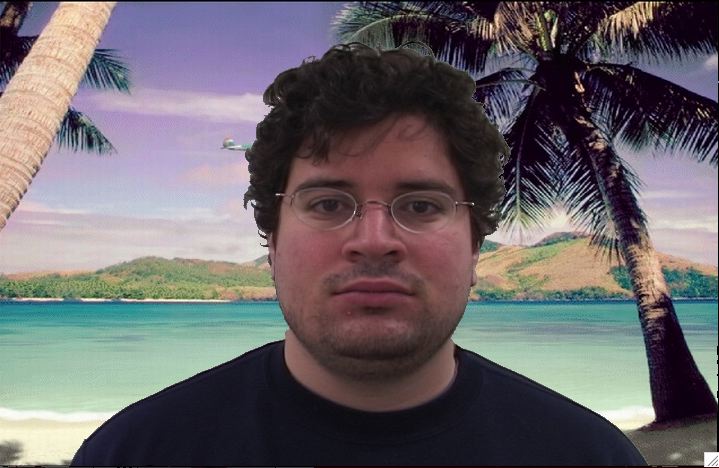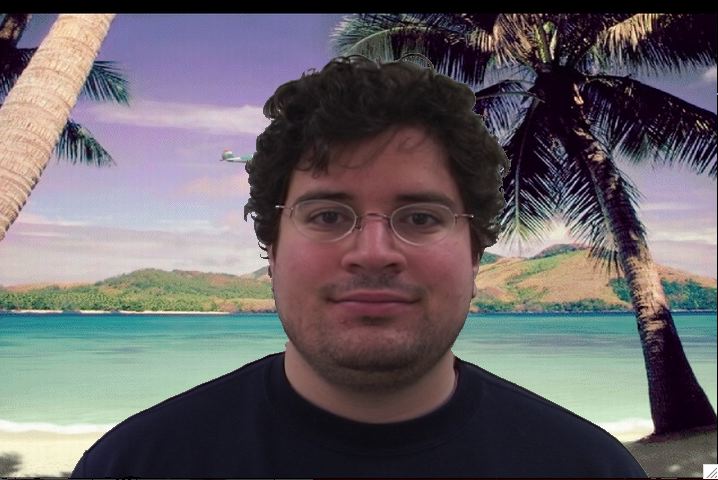max van kleek
6.869 problem set zero
problem one
original = im2double(imread('data/original.tif'));
whitefield = im2double(imread('data/whiteField.tif'));
corrected = original./whitefield;
oldcmap = colormap;
colormap(repmat([0:0.01:1]',1,3));
imagesc(corrected.^.05);
result:

problem two
part a) simulate an RGB filter
% simulate rgb filter
bt = imread('data/brettan.tif');
bt = im2double(bt);
mask = repmat(permute(eye(3),[3 2 1]),size(bt,1),floor(size(bt,2)/3));
% cut off rounding error
bt=bt([1:size(bt,1)],[1:(3*floor(size(bt,2)/3))],:);
btrgb = sum(bt .* mask,3);
cmap = colormap; % stow away the old cmap
colormap(repmat([0:0.001:1]',1,3));
imagesc(btrgb);
result:
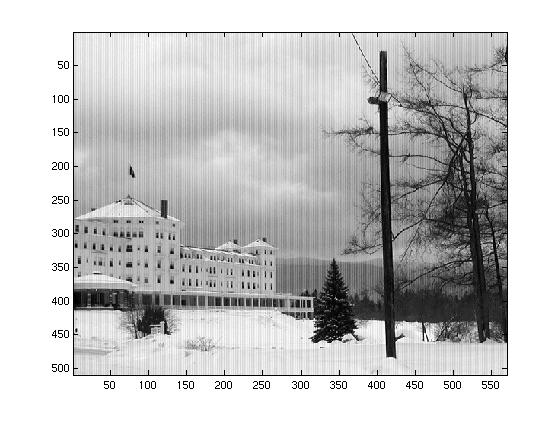
part b) linear interpolation of colors to reconstruct color
btvr = zeros(size(btrgb));
btvg = zeros(size(btrgb));
btvb = zeros(size(btrgb));
ridx = find(mod(find(btrgb),3)==1);
ridx = ridx([1:3*floor(length(ridx)/3)]);
gidx = ridx + 1;
bidx = ridx + 2;
btvr(ridx)=btrgb(ridx);
btvr(ridx+1)=2.0/3.0*btrgb(ridx) + 1.0/3.0*btrgb(ridx+3);
btvr(ridx+2)=1.0/3.0*btrgb(ridx) + 1.0/3.0*btrgb(ridx+3);
btvg(gidx)=btrgb(gidx);
btvg(gidx+1)=2.0/3.0*btrgb(gidx) + 1.0/3.0*btrgb(gidx+3);
btvg(gidx+2)=1.0/3.0*btrgb(gidx) + 2.0/3.0*btrgb(gidx+3);
btvb(bidx)=btrgb(bidx);
btvb(bidx+1)=2.0/3.0*btrgb(bidx)+1.0/3.0*btrgb(bidx+3);
btvb(bidx+2)=1.0/3.0*btrgb(bidx)+2.0/3.0*btrgb(bidx+3);
bt = cat(3,btvr,btvg,btvb);
figure(1);
imagesc(bt);
title('brettan.tiff');
result:
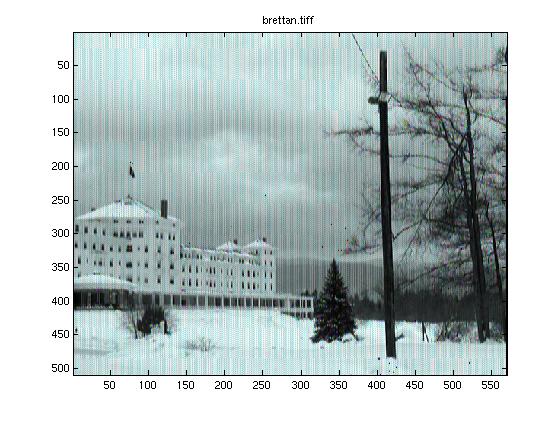
closeup of artifacts:
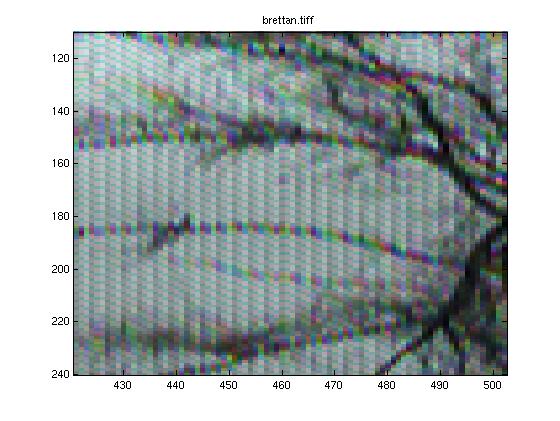
now try the same process with blurred version:
result:
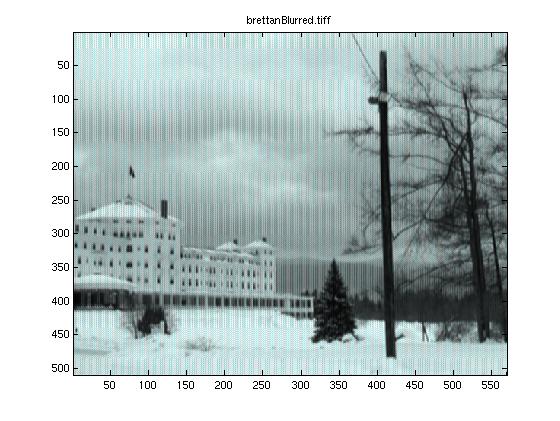
closeup of blurred:

definitely fewer artifacts, but we also see overall general loss of sharpness.
problem three: object metamorphosis
part a) warp each image to the average shape:
sm = imread('data/smile.jpg');
sm = im2double(sm);
load('data/flowNS.mat');
xcoo = meshgrid([1:size(sm,2)],[1:size(sm,1)]) + 0.5*flowNS(:,:,1);
ycoo = meshgrid([1:size(sm,1)],[1:size(sm,2)])' + 0.5*flowNS(:,:,2);
xs=meshgrid([1:720],[1:480]);
ys=meshgrid([1:480],[1:720])';
for i=1:3, mario(:,:,i) = interp2(xs,ys,sm(:,:,i),xcoo,ycoo); end;
figure(6);
imagesc(mario);
results:
| neutral | smile |
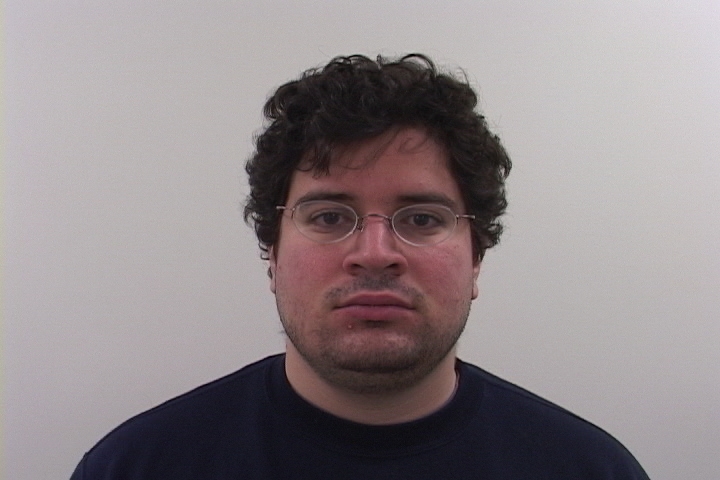 | 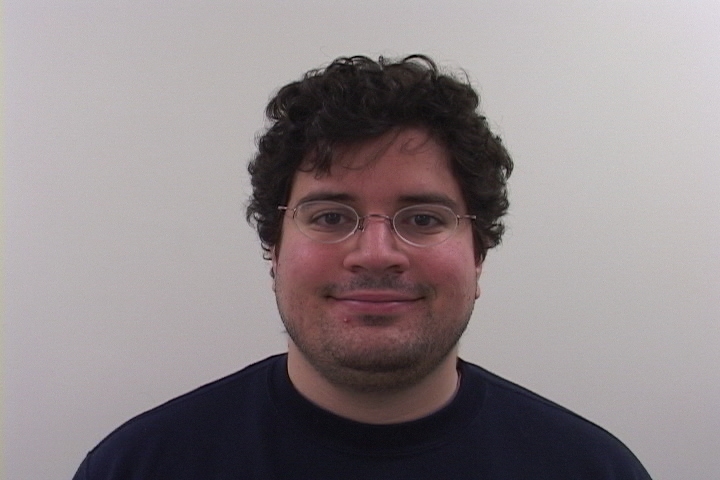 |
average:
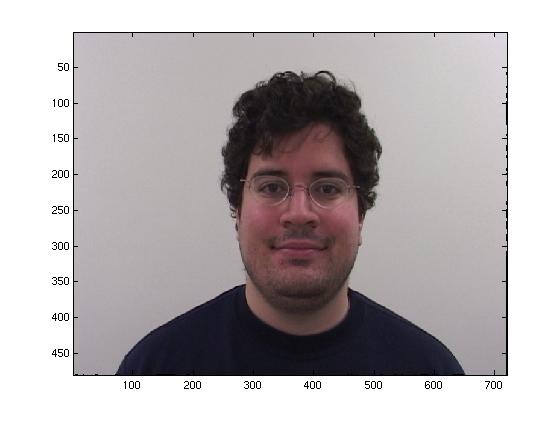
part b) compute a smooth transition between images
a function to make it more convenient to compute intermediate images:
function img = morph(src1,src2,fv1,fv2,alpha)
% alpha <= 0 <= 1.0
% returns an image representing flowvec from src1->src2
% assumes src1 and src2 are the same dimension
img = [];
xmesh = meshgrid([1:size(src1,2)],[1:size(src1,1)]);
ymesh = meshgrid([1:size(src1,1)],[1:size(src1,2)])';
xc1 = xmesh + alpha*fv2(:,:,1);
yc1 = ymesh + alpha*fv2(:,:,2);
xc2 = xmesh + (1.0-alpha)*fv1(:,:,1);
yc2 = ymesh + (1.0-alpha)*fv1(:,:,2);
for i=1:3,
img(:,:,i) = (1.0-alpha)*interp2(xmesh,ymesh,src1(:,:,i),xc1,yc1) + ...
(alpha)*interp2(xmesh,ymesh,src2(:,:,i),xc2,yc2);
end;
% nuke the nans!
img(isnan(img)) = 0;
then all we have to do is invoke it:
sm = imread('data/smile.jpg');
sm = im2double(sm);
nt = imread('data/neutral.jpg');
nt = im2double(nt);
load('data/flowNS.mat');
load('data/flowSN.mat');
for i=1:10,
subplot(5,2,i);
imagesc(morph(nt,sm,flowNS,flowSN,1.0/10.0*i));
end;
result:
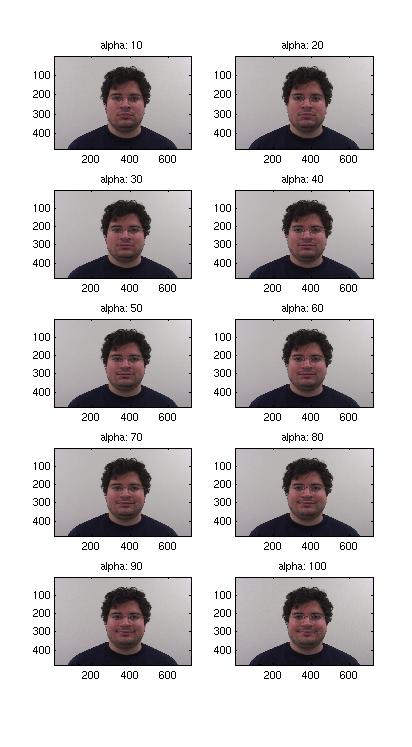
problem four: background subtraction
first make a helper function for calculating the mahanoboulis function:
function d = mahanoboulis(xs, mean, cov)
% calculates the mahanoboulis distance of x from mean/cov
% xs should be row-per-observation, column per variable
% mean should be a row vector
means = repmat(mean,size(xs,1),1);
size(means)
size(cov)
di = (xs-means);
size(di)
da = di*pinv(cov);
N = size(xs,1);
for j=1:3,
dz(j,:) = (da(:,j).*di(:,j))';
end
d = sum(dz)';
and a function that will help us vectorize the image into a single vector of [R G B] columns:
function p = picpermute(imagedata)
%p = reshape(permute(imagedata, [1 3 2]),[size(imagedata,1)*size(imagedata,2) 3 1]);
p(:,:,1) = reshape(imagedata(:,:,1),[size(imagedata,1)*size(imagedata,2) 1 1]);
p(:,:,2) = reshape(imagedata(:,:,2),[size(imagedata,1)*size(imagedata,2) 1 1]);
p(:,:,3) = reshape(imagedata(:,:,3),[size(imagedata,1)*size(imagedata,2) 1 1]);
p = permute(p,[1 3 2]);
similarly, a function to un-vectgorize the image back to color planes:
function smm = unpicpermute(imgdata, originalimg)
% takes a column (r g b) linear space
imgdata = permute(imgdata, [1 3 2]);
planesize = size(originalimg(:,:,1));
sm1 = reshape(imgdata(:,:,1),planesize);
sm2 = reshape(imgdata(:,:,2),planesize);
sm3 = reshape(imgdata(:,:,3),planesize);
smm = cat(3,sm1,sm2,sm3);
putting the pieces together:
%% backgrounds
% first grab some of the background pixeels
sm = imread('data/smile.jpg');
sm = im2double(sm);
bkpix = sm([1:350],[1:241],:);
bkpixp = picpermute(bkpix);
bkmean = mean(bkpixp);
bkcov=cov(bkpixp);
smp = picpermute(sm);
bkidx = find(mahanoboulis(smp,bkmean,bkcov)<200);
smp(bkidx,:,:) = repmat([0 0 0],size(bkidx,1),1);
smnew = unpicpermute(smp,sm);
imagesc(smnew);
result:
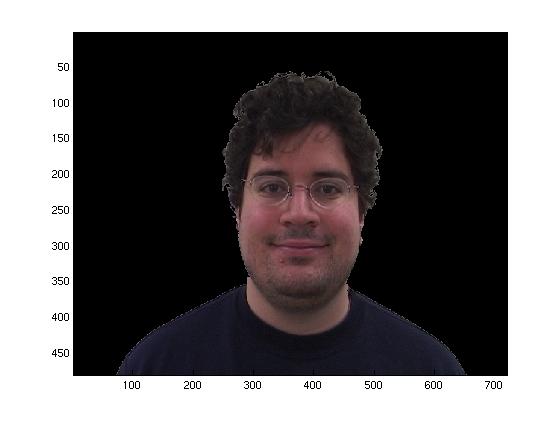
applying some erosion:
se = strel('line',2,90);
imagesc(imerode(smnew,se));
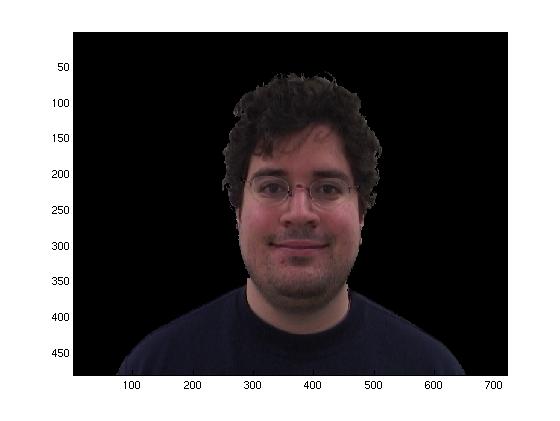
a function to help us turn it into a movie:
function movie = ps0movie(img1,img2,bkimg,fv1,fv2,frames)
frame = 1;
sequence = [];
bkimgp = picpermute(bkimg);
for alpha=0:(1.0/frames):1,
img = morph(img1,img2,fv1,fv2,alpha);
nans = isnan(img);
img(nans) = 0;
bkpix = img1([1:350],[1:241],:);
bkpixp = picpermute(bkpix);
bkmean = mean(bkpixp);
bkcov=cov(bkpixp);
smp = picpermute(img);
bkidx = find(mahanoboulis(smp,bkmean,bkcov)<200);
smp(bkidx,:,:) = bkimgp(bkidx,:,:);
img = unpicpermute(smp,img);
%max(img)
%max(max(img))
%maximgg = max(max(max(img)))
%minimgg = min(min(min(img)))
%size(img)
%im2frame(img,colormap)
sequence(:,:,:,frame) = img; % /(max(max(max(img))));
% figure(frame);
% imagesc(img);
frame = frame + 1;
end;
movie = images2movie(sequence);
results:
